by
O.W. Deaton
Centro Agronómico Tropical de
Investigación y Ensemanza
(CATIE)
Turrialba,
Costa Rica
Summary
In tropical America local breeds are not well defined and the lack of breeder societies to promote their diffusión and improvement is evident. Local 'breeds have already been reduced to low numbers although many of their genes are still available. The inflow of exotio genes is not based on the real needs of farmer-producers but on foreign and local commercial interest. The ecological and economic environment in the tropics calis for some use of genes from adapted breeds.Selected local breeds, new breeds and organized crossing systems utilizing local and exotios are needed. The transference of sophisticated technology and specialized breeds and production systems should be re-evaluated on a broad socio-economic basis, Financing long-term programmes should receive priority.
16.1 Introduction
As a matter of introduction and clarification it is perhaps necessary to define the "universe" which will be considered throughout my discussion. This should be useful to avoid possible confusion. As my experience is limited to cattle, I will not pretend to make inferences about other species, although they may sometimes be valid. In like manner this discussion is intended only to have generalized validity for the tropical areas of South and Central America.
Finding reliable quantitative data regarding the distribution of local breeds in tropical America is a very problematic task. This is because surveys are not frequently made, and little attention is given to breed identification as well as the fact that data are not widely or promptly published. The absence of Herdbook Societies or Breeders Registry Clubs, either private or official, is an indicator of the limited interest in Criollo cattle. Breed composition must be estimated by observed phenotypic "eyeball sampling" or inferred by such indicators as importations of foreign animals or semen if such data exists.
One should distinguish between the decline or loss of a breed as opposed to the decline or loss of genetic variation which a breed represente. Obviously the former can be, but not neoessarily is, a first phase of the latter. Continuous orossing to another breed if practised on an original breed will cause the disappearance of that breed and eventually the genetic variability which was associated with it will also disappear. However, a breed (identifiable group with unique gene combinations) can disappear by crossing but not follow the path of disappearing genetic variation providing inter-se or rotational matings are continued.
Genetic variation can persist for many generations in crossbred cattle especially for those loci which have a true heterotic effect for fitness. Under tropical conditions the procese of genetic dilution by "upgrading" is more prolonged in time than would be the case elsewhere. The herd "turnover" rate in the tropics is relatively slow due to poor reproduction, delayed age of sexual maturity and a weak artificial selection pressure.
16.2 Criollo, ...breed, breeds or population
The definition of breed is also a confusing factor when one refers to the local cattle of Latin America. The use of the term Criollo varias considerably between and within countries and social strata. To the general public Criollo may imply local but of European or mixed descent or simply common, nondescript or unimproved cattle which are not of the modern, well recognized breeds. Criollo cattle are usually considered of Iberian origin although the name is also applied to mixtures with noticeable zebu or specialized dairy breed characteristics. As such, Criollo cattle are a heterogenous population with extremely variable colours, sizes and other external traits. In a few cases more uniform sub-popul-ations are termed Criollo breeds. Several such Criollo breeds are knovm and recognized especially in Colombia and Venezuela, Only a few Criollo breeds are considered specialized (the Romo-Sinuano and the San Martinero of Colombia are considered to be beef breeds) whereas Criollos in most of Latin America are considered as dual-purpose (beef and milk) and sometimos also draft breeds. Recent attempts have been made to give a new ñame and thus identify certain types of Criollo cattle as improved or selected breeds (Limonera, Lechero Centroamericano) as distingaished from ordinary Criollos. Until an entire gener-ation has become familiar with the new name these efforts are more likely to further confuse the situation.
16.3 Causes of reduction in local breeds
To visualize more clearly the process and motivation of the reduction of local cattle, one may build a "pedigree" of the situation. As such the close anoestors would be the more immediate and mechanical processes which can be observed and classified. Extending the pedigree farther back one can identify more general and harder-to-measure processes especially economic, social and psychological motivations. Finally, the last identified distant anoestors can be oonsidered the underlying biological and ecological foundations which are often interrelated and frequently repeated at different levels in the pedigree.
The pedigree of: "Disappearing Genes" (see Appendix 1) is an attempt to conoeptualize the situation. In the form of the path pedigree it can be seen that a "Progressive Image, Imported" is an immediate and important source of influenoes, contributing to both sides of the pedigree. Farther toward the base or origin we may note that "Production" and "Improved Husbandry" contribute to the situation by various routes noticeably through "Publicity" and "Commercial Propaganda111. Finally "Heterosis" has produced multiple influences although the best known route has been via "Misinterpreted".
In examining the phenotypes of pedigrees we must recognize and be cautious of some of their obvious limitations. These inherent limitations refer to misleading names, errors of identification and the selected and often subjective nature of the information pre-sented. The lack of quantitative data or contemporary information seriously restricts our evaluation. Furthermore it has long been recognized that remote information is of limited value because it is less complete, less accurate and more diluted. However, the repetition of common causes (anoestors) often induces us to become interested in the magnitude of influence as well as some of the subsequent relations involved.
Possibly a more understandable interpretation of the situation would be chronological rather than the pedigree analysis previously mentioned.
The evolutionary history of cattle populations certainly has produced breeds with widely varying gene frequencies and phenotypes. The fact that some breeds have higher average yields than others, for example, probably is one of the basic reasons which eventually led to proliferation at the expense of a lower producing competing breed. The heterosis manifested in crosses also has been an important impulsor of the substitution of certain breeds by others. Hybrid vigour has often been mistakenly interpreted as super-iority of the imported parental breed and thus contributed to further dilution of local breeds. The adaptation and maternal ability of the local breed parent is often discarded while improvements in management usually helps overevaluate the imported stock. The expansion of the Braham at the expense of Criollos in the American tropics is a olear example of such confounding interpretation of heterosis.
To analyze breed tendencias it is helpful to look at the different kinds of persona or groups which are involved in causing or carrying out these processes. Educators, profess-ionals, commercial salesman, journalist and other persons not direotly dependent on cattle production are probably more influential than farmer-producers in promoting (or destroying) a given breed. These "intermediates" can be called catalysts of change whereas farmers are are more correctly instrumente of change. Obviously a rigid distinction cannot be made between them. As the ecological, economic and social background of these catalysts and instrumente (as persons or institutions) differ, some inferences can be made toward evalua-ting their methods and motives. The only general conclusion which seems valid is that the system (Appendix 2) is uribalanced. This is because genes, as breeds, only flow in one direction toward commercial producers and small farmers while monetary flow is the reverse. Even the flow of information, which is geographically biased, is not adequately balanced.
16.4 Central America: An example of tropical cattle production
In Central America, as perhaps in many tropical areas in the world, most of the cattle are on small and medium farms which are not specialized. Most such farmers have called these "dual-purpose" enterprises; but should not be considered similar to the dual-purpose farms of North America or Europe. The tropical dual-purpose cattle farm is an extensivo operation, where in cows are milked once per day with calf at side. The calves are separated or penned at night and run in the pasture with their dams during most of the day. Most herds are mixtures of different breeds and crosses but usually have considerable Zebu influenoe. Typically, yields are low, lactations are short, calving intervals are long (over 16 months), and weaning weights are very poor. Calf mortality usually results in the losa of the lactation by immediate drying off of the dam. Often the bull in use is either grade Braham, Brown Swiss, or Holstein depending on the current relativo price of beef to milk. However, delayed weaning of the young bulls frequently results in any type of mating including close inbreeding.
The production of cheese is a very significant enterprise on many farms, especially in dual-purpose herds. In most of the hilly areas of Central America, especially in coffee and sugar cane zones, oxen are an important source of energy and are not likely to be replaced by petroleum-powered machines in the near future. Beef prices in Central America fluctuate drastically as a direct result of export demand although local per capita consum-ption levels are very low. The internal market for beef in the Central America countries does not discriminate quality or grade with significant pricing compensations. Export beef is sold as frozen boxed beef which is eventually consumed in ground or canned mixes.
Some interesting data have been reportad (Appendix 3-A) on the contribution of different type herds to the total beef and milk production in Central America. Mixed or "dual-purpose" herds accounted for two-thirds of the beef and nearly three-fourths of the milk in Central America in 1971. Possibly since this Btudy was made some reduction in the number of animals in mixed herds or increases in specialized herds have occurred but it is indeed unlikely that mixed herds do not represent the majority of cattle in the region.
Cattle production in Central America can be easily classified as pasture dependent as the importance of grains and concentrates represent a very minor portion of the total feed resources utilized. Only very high producing dairy cows can complete economically advant-ageously 'with pigs, chickens, or the human population for these grains.
16.5 Small farmers
Small farmers or farmers of limited resources are abundant in the tropics. They are easily visible not only by their number but by obvious low productivity and difficult living conditions. Many are located in isolated areas deficient in roads, schools, and markets. A considerable number are isolated only in the sense of their lack of exposure to modern technology, oredit and social assistanoe servlces. Parro animals often play a secondary role as a source of direct income but a very significant and essential role with regards to feeding their families. A brief consideration of the small farmer who keeps livestock should be of interest in examining the breed and breeding tendencies which he implemente.
Although normally of a conservative nature, most small farmers are very status oonscious and thus very prone to certain kinds of propaganda and even commercial exploitation. As breeders of livestock, small farmers usually imitate their large farm neighbours or hobby breeders, The very small stock owner must depend on his neighbour's bull or artificial insemination if he does not use a homebred animal being grovm out for slaughter, Many small farmers do not raise their own herd replacements but depend on opportunity buying and sales to maintain their herds. The breeding policy most commonly practised by small farmers is a result of: first, what he can financially afford, secondly, what is most convenient; and later, what others convince him is the timely trend.
Multi-purpose animals are considered important as insurance against unstable markets. The system demands hardy animals, which are mediocre producers, demand less health care, and suffer less under management and irregular and defioient feeding systems• Small farmers tend to want to own more animals of a mediocre quality in preference to fewer high quality ones, The protection against risk of loss by the death of a single animal is a very important consideration to the small farmer. (see Appendix 3B,C,D)
16.6 Possible actions in conservation of local breeds
The actions which may contribute to conserving valuable genetic material are not new, in fact, some have been suggested many years ago, Furthermore some of these actions have been initiated and are being currently developed by private, national and international organizations, FAO being the most conspicuous, These actions, with some comments, may include:
1. Identifying the more useful breeds, lines or types.
In this area it is important to include an evaluation of the prevailing environment and management systems. Some evaluation of adaptive, hard-to-measure traits must be included in an overall or complete economic assessment for practical producers, Compar-isons involving the use of known reference breeds or crosses can raake this information much more meaningful and thus deserves high priority.
2. Stimulate and assist farmer-breeders of local breeds.
Direct subsidies, recognition and technical assistance should be considered, Support for practical farm recoding schemes and organizing Breed Registry Groups seems to be logical routes in the initiating phases, Care should be taken to avoid some of the errors of traditional Herdbook Societies, That is, deemphasize the importance of an ideal con-formation, rigid colour discrimination, or purity by closed herdbook.
3. Dissemination of semen.
Principally to experimental station or University herds but also to private breeders. Semen usage in herds of specialized dairy or zebú oows should be promoted, The idea being to produce crossbreds useful for less specialized herds, In cases where A.I. is difficult the use of bulls of crossbred origin could be promoted, This action could be expanded to include frozen embryos when the technique becomes economically practical.
4. Identify management systems wherein local breeds (or crosses) are beneficial.
Small farmers in marginal areas are the most likely to benefit from such information, Practical recording schemes for unsophisticated, non-specialized small farmers should complement breed evaluation, Overall economic merit must be the basis of comparing breeds or crosses.
5. Organize and coordinate National (or International) Programmes.
Finding stable financial support for worthy programmes would likely be the major activ-ity of this category, Such coordination must necessarily be a well known international organization - such as FAO.
Long range programmes which are olosely identified with farmer-produoers and include training programmes are the most likely to succeed, yet such programmes are often the most difficult to finance.
16.7 Justifications for conservation of local breeds.
The need for action to conserve an improve local breeds or types of farm animals is much broader than the preservation of potentially useful genetic material for the distant future. The need also goes beyond sentimental, historical or recreation justifications which we may call cultural needs. That is, there are immediate economical and social reasons including the nutritional wellbeing of vast numbers of the rural population espeo-ially, but not exolusively, those living in marginal environments and often far removed from the mainstream of society or even isolated from the influenoes we usually associate with good living standards.
La discussion est limitée aux bovina et à l'Amérique tropicale centrale et méridionale.
On manque de données quantitatives parce qu'il n'y a presque pas d'informations pub-liées et parce qu'il n'existe pratiquement pas de sociétés de livres généalogiques pour les races Criollo. La définition du terme Criollo est aussi très confuso, celui-ci s'appliquant parfois à des sous-groupes plus ou moins définis et d'autres fois à des bovins non améliorés, mélangés ou non définis d'origine ibérique. II existe des Criollo dans presque tous les pays latino-américains, mais les sous-populations ou les races les plus facilement identifiables sont concentrés en Colombio, au Venezuela et en Amérique céntrale. En général, les Criollo sont considérés comme des races à deux fins, à de rares exoeptions près comme les races colombiennes Romosinuano et San Martinero.
De toute évidence, l'une des raisons essentielles de la prolifération de certaines races aux dépens d'autres réside dans les différences observées en ce qui concerne leur production ou leur rendement. Toutefois, la plus grande partie des effets initiaux des croisements ont été" attribués à tort à l'hétérosis et à l'amelioration des pratiques zoo-techniques, cette erreur s'expliquant par le fait que les races exotiques et les produits de croisement avec les races exotiques ont presque toujours été éléves dans un environne-ment plus favorable. Dans le cas des croisements avec des races laitières spécialisées, les rendements plus eleves par lactation, largement vantés par une publicité massive, ont entrainé une "amélioration" suffisante pour éliminer pratiquement tous les Criollo locaux des troupeaux dans les zones plus froides où les pratiques zootechniques étaient essentielle-ment les memes que dans les pays développés temperes. Dans les plaines plus chaudes, les élevages bovins se spécialisent dans les bovins de boucherie, élévent des animaux à deux fins ou pratiquent un élevage laitier extensif. Dans ces régions basses et chaudes, les Criollo ont fait l'objet de croisements continus surtout avec des Brahman mais aussi avec quelques races laitiéres spécialisées. L'effet d'héterosis a été spectaculaire, mais les éleveurs ont généralement attribué les résultats à la supériorité des races exotiques et ont poursuivi les croisements sans considérer l'importance des aptitudes maternelles ou de la contribution adaptative des Criollo. La propagande commerciale, surtout par l'inter-médiaire des expositions et des foires mais sans s'appuyer sur des preuves solidement documentées d'une production supérieure, a contribué à faire en sorte que la race Brahmán dilue fortement les populations de Criollo.
La plupart des bovina d'Amérique tropicale se trouvent dans des troupeaux d'animaux à deux fina. Ces élevages extensifs produisent la plus grande partie du lait destiné au marché,bien qu'ils soient biologiquement et économiquement très inefficaoes. L'instabilité du marché, le caraetáre cyclique des ressources fourragires et la concurrence des cultures de rapport (pour les capitaux et la main-d'oeuvre) sont les principales raisons pour les-quelles les agrioulteurs ne se préoccupent pas slrieusement des objectifs de séleotion.
Pour prendre leurs décisions les petits paysans tendent à suivre l'exemple des grande exploitants et de ceux qui pratiquent l'élevage comme passe-temps en matière de séleotion. Be ce fait, ils sont beaucoup plus vulnerables aux influences de la publicité et de la promotion commerciale. II faut reconsidérer dans un contexte socio—éoonoraique élargi le transferí de races bovines spécialisées à haut rendement et de teohnologies sophistiquées. II faut trouver des systèmes d'exploitation dans lesquels les races locales et les produits de croisement ont un r�le approprié.
El análisis se limita al ganado vacuno y a la zona tropical de América Central y del Sur. faltan datos cuantitativos debido a que no se dispone en general de información publicada y a que no existen prácticamente asociaciones del libro genealógico para las razas criollas» Existe además una confusión general respecto a la definición del termino criollo, ya que a veces se refiere a subgrupos más o menos definidos y, a veces, a ganado vacuno no mejorado, mezclado o no descrito de ascendencia ibérica. Aunque existe ganado vacuno criollo en la mayor parte de los pafses de América Latina, las subpoblaciones o razas más fácilmente identificadas están concentradas en Colombia, Venezuela y América Central» Por lo general el ganado vacuno criollo se considera de doble finalidad, con algunas excepciones como las razas Romosinuana colombiana y San Martinero.
Sin duda, una de las razones fundamentales de la proliferación de algunas razas a expensas de otras son las diferencias observadas en su producción o rendimientos» Sin embargo, la mayor parte del impacto o impulso inioial en los cruzamientos se han confundido o mezclado con la heterosis y con una mejor zooteonia, debido a que las razas exóticas y sus cruzamientos con ganado criollo se han criado casi siempre en un ambiente más favorable» En el caso de cruzamientos con razas lecheras especializadas los mayores rendimientos de la lactación respaldados por la propaganda y publicidad de los medios de comunicación han provocado suficiente "mejoramiento" hasta eliminar prácticamente todo el ganado vacuno criollo de los hatos de las zonas más frías, donde la cría de ganado ha sido fundamentalmente la misma que en los países templados desarrollados» En las tierras bajas más cálidas las empresas ganaderas están especializadas en producción de carne, en la doble finalidad o en producción lechera extensiva» En estas regiones bajas cálidas, el ganado vacuno criollo se ha cruzado continuamente con ganado Brahman sobre todo, pero tembién con algunas razas lecheras especializadas» Aunque la heterosis ha sido impresionante, los agricultores han atribuido, por lo general, los resultados a la superioridad de la raza exótica y han continuado majorando sin evaluar la importancia de la capacidad materna o de la aportación en materia de adaptación del ganado vacuno criollo. La propaganda comercial, sobre todo mediante muestras y ferias, pero sin el respaldo de registros de produooión superior, ha sido eficaz para hacer que la raza Brahman diluya gravemente las poblaciones de ganado criollo.
La mayor parte del ganado vacuno de las Américas comprendidas en el trópico son hatos de doble finalidad» Estas explotaciones extensivas producen la mayor parte de la leche para el mercado, aunque son bastante poco eficientes desde un punto de vista biológico y económico. Las razones principales por las que los agricultores no prestan una mayor atención a los objetivos de la raza o a los programas de mejoramiento parecen ser la inestabilidad del mercado, la disponibilidad cíclica de los forrajes y la competencia con cultivos comerciales (en cuanto a mano de obra y capital).
Los pequeños agricultores tienden a seguir el ejemplo de los grandes agricultores y de los majoradores no profesionales en sus decisiones en materia de mejoramiento de ganado vacuno. Por ello, son mucho más vulnerables a la influencia de la propaganda, la publicidad y la promoción comercial. Hay que reevaluar la transferencia de razas especializadas de ganado vacuno con elevado rendimiento, así como las tecnologías sofisticadas, teniendo en cuenta una amplia base socioeconómica. Es necesario identificar sistemas de manejo que permitan aprovechar las razas locales y sus cruzamientos.
| Appendix 1-A | Pedigrees of "Ancestore" of "Disappearing Genes" | ||
| NAME: | Progressive Image, Imported | ||
| CODE NAME: | Mr. Modern | ||
| BRED BY: | Grairibelt Farm | ||
| ADDRESS: | Industrialville | ||
| OWNED BY: | Ministrar of Agriculture | ||
| ADDRESS: | Studied Abroad Road, Me Too Land | ||
| COLOUR: | Dark | ||
| PEDIGREE: | Mr. Modern | Performance | Production | ||
| Records |
Improved Husbandry |
||||
| Publicity |
Performance Records |
||||
| Expositions |
| NAME: | Dilution by Crossing |
| CODE NAME: | Near Pure |
| BRED BY: | Salesmanship Syndicate |
| ADDRESS : | High Input Farm, Goodlands |
| OWNED BY: | B. Practical |
| ADDRESS: | Machinery Road, Goodlands |
| COLOUR: | Common |
| PEDIGREE: | Near Pure | Progressive |
Performance Records |
||
| Image Imported | Publicity | ||||
| Continuous | Heterosis | ||||
| Upgrading |
Maternal Traits |
| Appendix 1-A | Pedigrees of "Ancestors" of "Disappearing Genes" | ||
| NAME: | Continuous Upgrading | ||
| CODE NAME: | Misinterpreted | ||
| BRED BY: | Empirioal View Farm | ||
| ADDRESS: | Midasville | ||
| OWNED BY: | Masses Farm | ||
| ADDRESS: | Bandwagon City | ||
| COLOUR: | Mosaicand blended | ||
| PEDIGREE: | Misinterpreted | Heterosis | Outbreeding | ||
| Recombination | |||||
| Maternal | Production | ||||
| Abilty | Adaptation |
| NAME: | Commercial Progress. |
| CODE NAME: | Dollarmaker |
| BRED BY: | Advertising Pays Firm |
| ADDRESS: | Pressville |
| OWNED BY: | Champion Fram |
| ADDRESS: | Fairs Road, Bankersville |
| COLOUR: | Ribbon Blue |
| PEDIGREE: |
Dollarmaker |
Heterosis | Outbreeding | ||
| Recombination | |||||
| Improved | More Feed | ||||
| Husbandry | Health Care |
| Appendix 1-A | Pedigrees of "Ancestors" of "Disappearing Genes" | ||
| NAME: | Substituto by Replacement | ||
| CODE NAME: | Easy gains | ||
| BRED BY: | National Purebred Club | ||
| ADDRESS: | Model Management Road | ||
| OWNED BY: | Doctors and Lawyers Ranch | ||
| ADDRESS: | Hobby Lane | ||
| COLOUR: | Pretty | ||
| PEDIGREE: |
Easy gains |
Progressive |
Performance Records |
||
|
Image Imported |
Publicity | ||||
| Commercial | Heterosis | ||||
| Propaganda |
Improved Husbandry |
| NAME: | Disappearing Genes |
| CODE NAME: | Disinherited |
| BRED BY: | Shrinking Alternatives |
| ADDRESS: | Problems Road |
| OWNED BY: | About Everbody Ranch |
| ADDRESS: | All over |
| COLOUR: | Fading |
| PEDIGREE: | Disinherited | Substitute |
Progressive Image, Imported |
||
| by Replacement |
Commercial Propaganda |
||||
| Dilution by |
Progressive Image, Imported |
||||
| Crossing |
Continuous Upgrading |
Appendix 1-B. Pedigree of "Disappear�ng Genes"
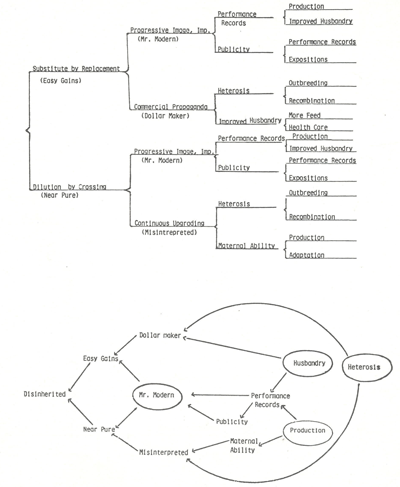
UNBALANCED SYSTEM OF GENE-CASH EXCHANGE
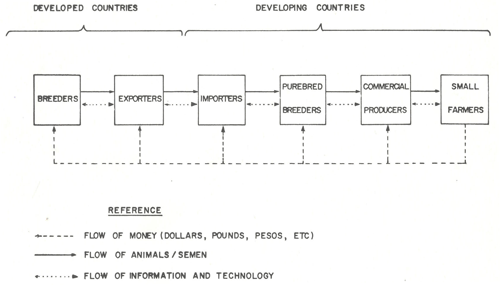
Appandix 2-B Theoretical Relation Between Gene Flow Distance and Other Variables
THEORETICAL RELATION BETWEEN GENE FLOW
DISTANCE AND
APPLICABILITY OF TECHNOLOGY
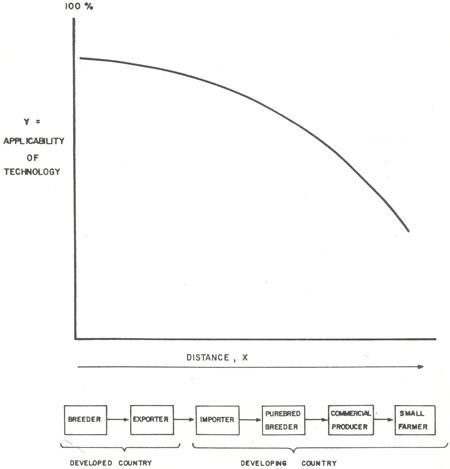
Appendix 2-B Theoretical Relation Between Gene Flow Distance and Other Variables
THEORETICAL
RELATION BETWEEN GENE FLOW DISTANCE
AND ANIMAL COSTS

Appendix 2-B Theoretical Relation Between Gene Flow Distance and Other Variables
THEORETICAL RELATION BETWEEN GENE FLOW DISTANCE
AND
ANIMAL PRODUCTIVITY LEVEL
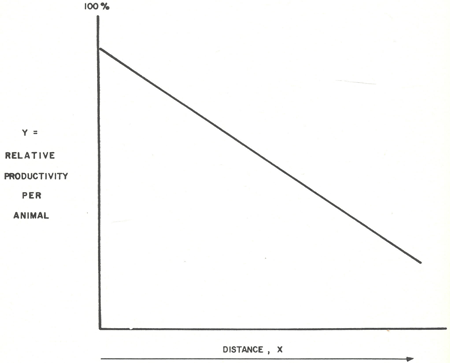
Appendix 2-B Theoretical Relation Between Gene Flow Djstance and Other Variables
THEORETICAL RELATION BETWEEN GENE FLOW DISTANCE
AND IMPORTANCE OF PASTURES
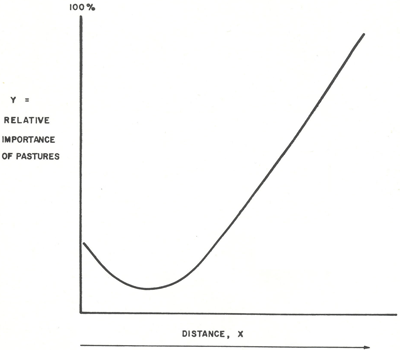
Appendix 3-A Existence and Production of Milk and Beef by Type of Herd in Central America
| Type of Herd | Animals |
Beef production |
Milk production |
|||
| Thous. | % | Thous. M.T. | % | Thous. M.T. | % | |
| Mixed | 6 089 | 78 | 139 |
66 |
766 | 72 |
| Dairy | 317 | 4 | 12 |
6 |
295 | 28 |
| Beef | 1 415 | 18 | 60 |
28 |
||
| Total | 7 821 | 121 | 1 061 | |||
| Source: |
Censos Agropecuari, SIECA/GAFICA. 1971. |
|||||
Appendix 3-B Small Farm Survey in Costa Rica. System of Cattle Production
|
No. Farms |
Percent |
||||
|
Beef |
3 |
1.3 |
|||
| Dairy |
35 |
12.2 |
|||
| Dual-Purpose |
192 |
83.5 |
|||
| Source: | Avila et al. CATIE. 1979. | ||||
Appendix 3-C Characteristics of Costa Rican Small Farms
|
Dairy Herds |
Dual-Purpose |
||
|
Use concentrate, % |
75 | 12 | |
|
Use fertilizer, % |
63 | 10 | |
|
Use credit, % |
60 | 40 | |
|
Reproduction, % |
83 | 69 | |
|
Milk/day/cow, litres |
6.7 | 2.0 | |
|
Calf mortality, % |
29 | 13 | |
|
Breed composition, % |
|||
|
- |
zebu | 0 | 32 |
| - | dairy | 54 | 14 |
|
- |
mixed or cross | 46 | 54 |
| Source: | Avila et al. CATIL. 1979. |
| Appendix 3-D | Characteristics of Tropical Dual-Purpose Cattle Enterprises | ||
| 1. | Traditional | ||
| 2. | Extensive - Mínimum technology | ||
| 3. | Product adjusted to seasonal changes | ||
| 4. | Low biological productivity | ||
| 5. | Economically - Low risk, low profit | ||
| 6. | Heterogenous breeding; | ||
| Various breeds and crosses | |||